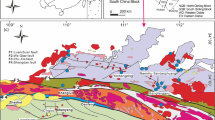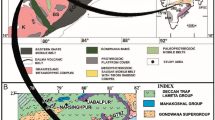Abstract
Radioactive minerals in pegmatites associated with granitic rocks are commonly encountered in the south of the Wadi Khuda area and found as dyke-like and small bodies. They are observed within garnet-muscovite granites near the contact with older granitoids. Field surveys indicated that the studied pegmatites vary in dimensions ranging from 2 to 10 m in width and from 10 to 500 m in length. They are composed mainly of intergrowth of milky quartz, reddish-pink K-feldspar and plagioclase together with small pockets of muscovite.
Field radiometric measurements indicated that radioactivity in pegmatites is more than twice that of their enclosing country rocks. Radionuclide measurements revealed that the average contents of U and Th increase gradually from rocks of dioritic to granodioritic composition (1.5×10−6 U and 4.3×10−6 Th) and increase significantly in biotite granites (5.8×10−6 U and 15.2×10−6 Th) but drastically decrease in muscovite granites (2.2×10−6 U and 5.6×10−6 Th). The average contents of U and Th of anomalous pegmatites are 95.3×10−6 and 116.9×10−6, respectively, indicating their uraniferous nature. In the south of the Wadi Khuda area, pegmatites are low in average Th/U (1.4) and high in average U/K (35.6), which suggests that uranium concentrating processes did not affect the pegmatites, indicating poor source-rocks.
Mineralogical investigations of the studied pegmatites revealed the presence of secondary uranium minerals (kasolite and autunite), in addition to zircon, thorite, apatite, garnet and biotite. Primary and secondary radioactive mineralizations indicated that the mineralization is not only magmatic, but also post-magmatic. Electron microprobe analyses showed distinct cryptic chemical zoning within thorite where UO2 decreases from core to rim. This feature in thorite is sporadic, suggesting non-uniform redistributions of UO2 within thorite during magmatic processes.
Similar content being viewed by others
References
Abdalla H.M. and El Afandy A.H. (2003) Contrasting mineralogical and geochemical characteristics of two A-type pegmatite fields, Eastern Desert, Egypt [J]. Egyptian Mineralogists. 20, 287–328.
Abdel Karim A.M. and E. Arva Sos. (2000) Geochemical characteristics and K-Ar ages of some granitoid from South Eastern Desert, Egypt [J]. Egyptian Journal of Geology. 44/1, 305–318.
Abdel Khalek M.L., Takla M.A., Sehim A.A., Abdel wahed M., Hamimi Z., and Sakran Sh.M. (1999) Tectonic evolution of the Shield rocks, East Wadi Beitan area, South Eastern Desert, Egypt [J]. Egyptian Journal of Geology. 43/1, 1–25.
Abdel Warith A., Raslan M.F., and Ali M.A. (2007) Mineralogy and Radioactivity of Pegmatite Bodies from the Granitic Pluton of Gabal Um Tager El-Tahtani Area, Central Eastern Desert, Egypt [C]. The 10th International Mining, Petroleum, and Metallurgical Engineering Conference, Mining, Code No. M3, Faculty of Engineering-Assuit University.
Adams J.A.S., Osmond J.K., and Rogers J.J.W. (1956) “The geochemistry of thorium and uranium”. In Physics and Chemistry of the Earth [M]. 2, 298–348.
Ahmed F.Y. and Abdel Warith A. (2003) Radioactive Studies of Gabal Um Dissi Younger Granites and the Associated Pegmatites, North Eastern Desert, Egypt, Al Azhar Bulletien of Science [C]. pp.25–27, 31–43. Proc. of 5th Int. Sci. Conf.
Ali M.A. (2001) Geology, Petrology and Radioactivity of Gabal El-Sibai Area, Central Eastern Desert, Egypt [D]. pp.300. Ph.D Thesis, Cairo University.
Ali M.A., Raslan M.F., and El-Feky M.G. (2005) Radioactivity and Mineralogy of Some Pegmatite Bodies from Gabal Al-Farayid Granites, South Eastern Desert, Egypt [C]. The 9th International Mining, Petroleum, and Metallurgical Engineering Conference February 21—24, 2005, Faculty of Engineering-Cairo University.
Cerny P. (1990) Distribution, affiliation and derivation of rare-element granite pegmatites in Canadian Shield [J]. Geologische Rundschau. 79, 183–226.
Dawood Y.H., Abd El-Naby H.H., and Sharafeldin A.A. (2004) Infuence of the alteration processes on the origin of uranium and europium anomalies in trachyte, central Eastern Desert, Egypt [J]. J. Geochem. Explor. 88, 15–27.
Deer W.A., Howie R.A., and Zussman J. (1992) Rock Forming Minerals, Vol. 5. Non Silicates [M]. John Wiley and Sons, New York.
Dixon T.H. (1981) Age and chemical characteristics of some Pre-Pan-African rocks in the Egyptian shield [J]. Precambrian Res. 14, 119–133.
El Aassy I.E., Shazly A.G., Hussein H.A., Heikel M.T.S., and El Galy M.M. (1998) Pegmatites of Nuweiba-Dahab Area, West Gulf of Aqaba, Sinai, Egypt: Field Aspects, Mineralogy, Geochemistry and Radioactivity [C]. pp.139–151. 3rd Conf. of Geoch. Alex. Univ. V.I., Geoch. of igneous rocks and Geochemical exploration, Alex.
El-Manharawy M.S. (1977) Geochronological Investigation of Some Basement Rocks in Central Eastern Desert, Egypt Between Lat. 25° and 26°N [D]. pp.216. Unpub. Ph. D. Thesis, Cairo University, Egypt.
El-Ramly M.F. and Akaad M.K. (1960) The basement complex in the Central Eastern Desert of Egypt between lat. 24°30′and 25°40′N [J]. Geological. Survey, Egypt. (8), 35.
Ford K.L. (1982) Uraniferous pegmatites of the Sharbot Lake area, Ontario. In Uranium in Granites (ed. Maurice Y.T.) [M]. pp.81–23, 125–138. Geol. Surv. of Canada.
Erict T.S. (2005) Identification and alteration trends of granitic-pegmatite-hosted (Y, REE, U, Th)-(Nb, Ta, Ti) oxide minerals: A statistical approach [J]. Canadian Mineralogist. 43, 1291–1303.
Gaberlman J.W. (1977) Migration of uranium and thorium exploration significance [J]. American Association for Petroleum Geologists Bulletin, Studies in Geology. APPG, USA. (3), 168.
Hanson S.L., Simons W.B., and Falster (1998) A.U., Nb-Ta-Ti oxides in granitic pegmatites from the Topsham pegmatite district, South Maine [J]. The Canadian Mineralogist. 36, 601–608.
Hassan M.A. and Hashad A.H. (1990) Precambrian of Egypt. The anorogenic alkalic rocks, South Eastern Desert, Egypt [J]. Annal Geological Survery 9, Egypt. 81–101.
Hume W.F. (1935) Geology of Egypt. Vol. II, Part II. The Later Plutonic and Intrusive Rocks. Geological Survery Egypt [M]. pp.301–688. Government Press, Cairo.
Hussein A.A., Ali M.M., and El-Ramly M.F. (1982) A proposed new classification of the granites of Egypt [J]. Journal of Volcanic and Geothermal Research. 14, 187–198.
Ibrahim M.E., Shalaby M.H., and Ammar S.E. (1997) Preliminary studies on some uranium and thorium bearing pegmatites at G. Abu Dob, Central Eastern Desert, Egypt [J]. Proc. Egypt. Acad. Sci. 47, 173–188.
Ibrahim M.E., Saleh G.M., and Abd El-Naby H.H. (2001) Uranium mineralization in the two mica granite of Gabal Ribdab, South Eastern Desert, Egypt [J]. Appl. Radiat. Isot. 55/6, 123–134.
Matolin M.M. (1991) “Construction and Use of Spectrometric Calibration Pads”, Laboratory of Gamma-ray spectrometry, N.M.A., Egypt [R]. A report to the Government of the Arab Republic of Egypt. Project Egy., 4, 030-03, IAEA.
Matsubara S., Kato A., and Matsuyama F. (1995) Nb-Ta minerals in a lithium pegmatite from Myokenzan, Ibaraki Prefecture, Japan [J]. Mineralogical Journal. 17, 338–345.
Moussa E.M.M., Stern R.J., Manton W.I., and Ali K.A. (2008) Shrimp zircon dating and Sm/Nd isotopic investigations of Neoproterozoic granitoids, Eastern Desert, Egypt [J]. Precamb. Res. 160, 341–356.
Osmond J.K., Dabous A.A., and Dawood Y.H. (1999) U series age and origin of two secondary uranium deposits, central Eastern Desert, Egypt [J]. Economic Geology. 94, 273–280.
Page L.R. (1950) Uranium in pegmatites [J]. Econ. Geol. 45, 12–34.
Pal D.C., Mishra B., and Bernhardt H.J. (2007) Mineralogy and geochemistry of pegmatite-hosted Sn-, Ta- Nb-, and Zr- Hf-bearing minerals from the southeastern part of the Bastar-Malkangiri pegmatite belt, Central India [J]. Ore Geology Reviews. 30, 30–55.
Raslan M.F. (2004) Physical properties of kasolite from Gabal Gattar uranium prospect, North Eastern Desert, Egypt [J]. Jour. Egyp. Mineralogist (in press).
Raslan M.F., El Shall H.E., Omar S.A., and Daher A.M. (2010) Mineralogy of polymetallic mineralized pegmatite of Ras Baroud Granite, Central Eastern Desert, Egypt [J]. Journal of Mineralogical and Petrological Sciences. 105(3), 123–134.
Rogers J.J.W. and Adams J.A.S. (1969) Uranium and thorium. In Handbook of Geochemistry (ed. Wedepohl K.H.) [M]. VII-3, 92-B-1 to 92-0-8 and 90-B-1 to 90-0-5, Springer Verlag, Berlin.
Rogers J.J.W. and Ragland P.C. (1961) Variation of thorium and uranium in selected granitic rocks [J]. Geochim. et Cosmochim. Acta. 25, 99–109.
Saunders D.F. (1979) Characterization of uraniferous geochemical provinces by aerial gamma-ray spectrometry [J]. Min. Eng. 31. 1715–1722.
Sayyah T.A., Assaf H.S.A., bdel Kader Z.M., Mahdy M.A., and Omar S.A. (1993) New Nb-Ta occurrence in Gebel Ras baroud, Central Eastern Desert [J]. Egyptian Mineralogist. 5, 41–55.
Shaw D.M. (1968) A review of K-Rb fractionation trends by covariance analyses [J]. Geochim. et Cosmochim. Acta. 32, 573–600.
Shurmann H.M.E. (1966) The Precambrian Along the Gulf of Suez and the Northern Part of the Red Sea [M]. E.J. Brill, Leiden, Netherlands.
Simpson P.R., Brown G.C., Plant J., and Ostle D. (1979) Uranium mineralization and granite magmatism in the British Isles [J]. Phil. Trans. R. Soc. London. A.291, 385–412.
Stohl F.V. (1974) The Crystal Chemistry of the Uranyl Silicate Minerals [D]. Ph.D. Thesis, The Pennsylvania State University, University Park.
Stohl F.V. and Smith D.K. (1974) The Crystal Chemistry of the Uranyl Silicate Minerals [C]. (abstr.) American Crystallographic Association Meeting, Program and Abstracts Ser. 2, 2, 271.
Stohl F.V. and Smith (1981) The Crystal Chemistry of the Uranyl Silicate Minerals [M]. Department of Geosciences, the Pennsylvania State University, University Park. Pennsylvania.
Stuckless J.S., Nkomo I.T., Wenmer D.B., and Van Trump G. (1984) Geochemistry and uranium favourability of the postorogenic granites of the north-eastern Arabian Shield, Kingdom of Saudi Arabia [J]. Bull Fac. Earth Sci. King Abdel Aziz Univ. 6, 195–209.
William S.B., Hanson S.L., and Falster A.U. (2006) Samarskite-Yb: A new species of the samarskite group from the Little Patsy pegmatites, Jefferson County, Colorado [J]. Canadian Mineralogist. 44, 1119–1125.
Author information
Authors and Affiliations
Corresponding author
Rights and permissions
About this article
Cite this article
Raslan, M.F., Ali, M.A. & El-Feky, M.G. Mineralogy and radioactivity of pegmatites from South Wadi Khuda area, Eastern Desert, Egypt. Chin. J. Geochem. 29, 343–354 (2010). https://doi.org/10.1007/s11631-010-0466-2
Received:
Accepted:
Published:
Issue Date:
DOI: https://doi.org/10.1007/s11631-010-0466-2




